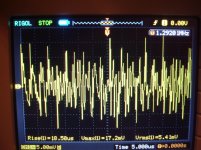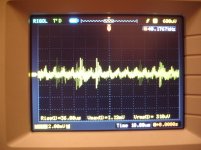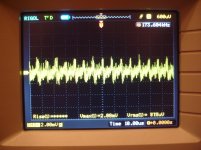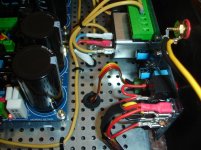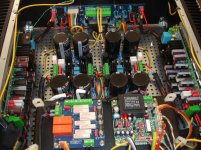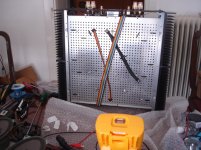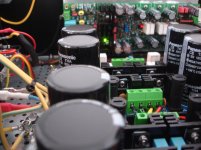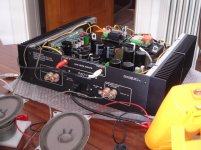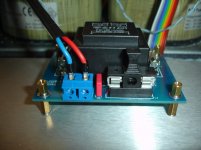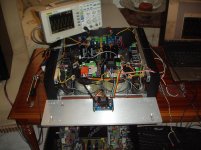same result when only one channel connected?
The amplifier pcb is isolated mounted on the heat spreader? The first prototype pcbs have the screw fields erroneously unisolated ...
The amplifier pcb is isolated mounted on the heat spreader? The first prototype pcbs have the screw fields erroneously unisolated ...
Last edited:
Yes,same.same result when only one channel connected?
The amplifier pcb is isolated mounted on the heat spreader? The first prototype pcbs have the screw fields erroneously unisolated ...
115mV for the CONNECTED channel ,7mV when laptop mute.
70uv for the DISCONNECTED channel.
I have isolate the mounting holes on the bottom using a dremel.
Last edited:
You have said you can hear nearly no noise with the ear on the speaker. maybe you measure some dac artefacts. laptop soundcards often have bad output filters and your amp has a very high power bandwidth.
use your scope to check the output signal frequency and amplitude.
use your scope to check the output signal frequency and amplitude.
Yes, i must put my ear in contact with the tweeter to be able to hear a very low level noise.You have said you can hear nearly no noise with the ear on the speaker. maybe you measure some dac artefacts. laptop soundcards often have bad output filters and your amp has a very high power bandwidth.
use your scope to check the output signal frequency and amplitude.
I tried to pull the jack and short this using an aluminium paper, the measurement is 0 mV.
The cable is like this but 1.5m
Attachments
Last edited:
Which way?A scope will bring light into darkness... 😉
Do you mean a new test using a generator and a scope seeing square waves?
I'm afraid that i can't understand what is this signal.😕No - just looking what kind of signal generates such noise or offset...
BR, Toni
This was measured at the output of the amplifier.
Attachments
Last edited:
looks like computer noise. a spectrum analyzer could help identify if a cheap switching power supply adds the high frequency noise. build a simple input filter with a -3 db @ 22 khz to verify this.
Aha now i know where is the problem.
GND loops with the earthed probe!
When i connect the scope with safe earth disconnected i measure those. R , L channels.
GND loops with the earthed probe!
When i connect the scope with safe earth disconnected i measure those. R , L channels.
Attachments
Last edited:
DAC artefacts maybe mixed with switching power supply artefacts.
gracefully to be ignored.
Have fun with your soon finshed amplifier!
Congrats!
BR, Toni
gracefully to be ignored.
Have fun with your soon finshed amplifier!
Congrats!
BR, Toni
I can't see problem except when an earthed switch mode power supply used for the laptop.DAC artefacts maybe mixed with switching power supply artefacts.
gracefully to be ignored.
Have fun with your soon finshed amplifier!
Congrats!
BR, Toni
I will post pictures from the semi finished amplifier soon.😉
Thanks Toni!🙂
Last edited:
Just before the final step.
Attachments
Last edited:
Dear Thimios,
looks pretty good! 🙂


I would do one change: the small signal lines (ribbon cables) route above in the middle of the amplifier. The sharp edges from the steel bottom may destroy the cables.
The signal cables carry only constant DC and speaker output signals decoupled by 4.7k (for DC detection).
BR, Toni
looks pretty good! 🙂



I would do one change: the small signal lines (ribbon cables) route above in the middle of the amplifier. The sharp edges from the steel bottom may destroy the cables.
The signal cables carry only constant DC and speaker output signals decoupled by 4.7k (for DC detection).
BR, Toni
Dear Toni,don't worry!🙂Dear Thimios,
looks pretty good! 🙂
I would do one change: the small signal lines (ribbon cables) route above in the middle of the amplifier. The sharp edges from the steel bottom may destroy the cables.
The signal cables carry only constant DC and speaker output signals decoupled by 4.7k (for DC detection).
BR, Toni
I will take care in the finally assembled amplifier.
I will enclose this ribbon cable (at these <<dangerous>> points) in a thermal shrinking tube.😉
Thanks a million!
Thimios
Finally the auxiliary power supply found that position.
Picture 2:Testing Power supply Ripple current.
The puzzle is close to the finalizing!
Picture 2:Testing Power supply Ripple current.
The puzzle is close to the finalizing!
Attachments
Last edited:
🙂 ... indeed very close to project end!
I see you have done some machining for the big power button and standby led too!
BR, Toni
I see you have done some machining for the big power button and standby led too!

BR, Toni
Yes the big hole is 12mm and must be 16mm,16mm don't fit in my drill Machine.🙂 ... indeed very close to project end!
I see you have done some machining for the big power button and standby led too!
BR, Toni
I will need friend's help again!
Last edited:
- Status
- Not open for further replies.
- Home
- Amplifiers
- Solid State
- SA2015 V-MOSFET Builders

